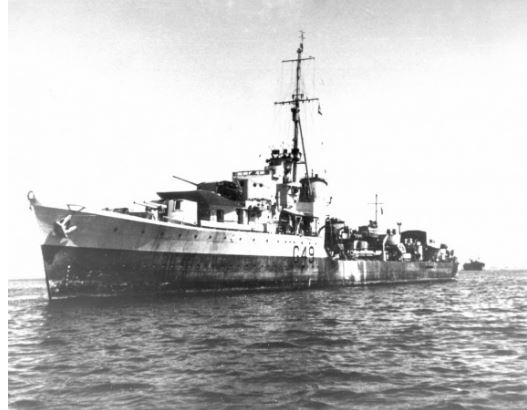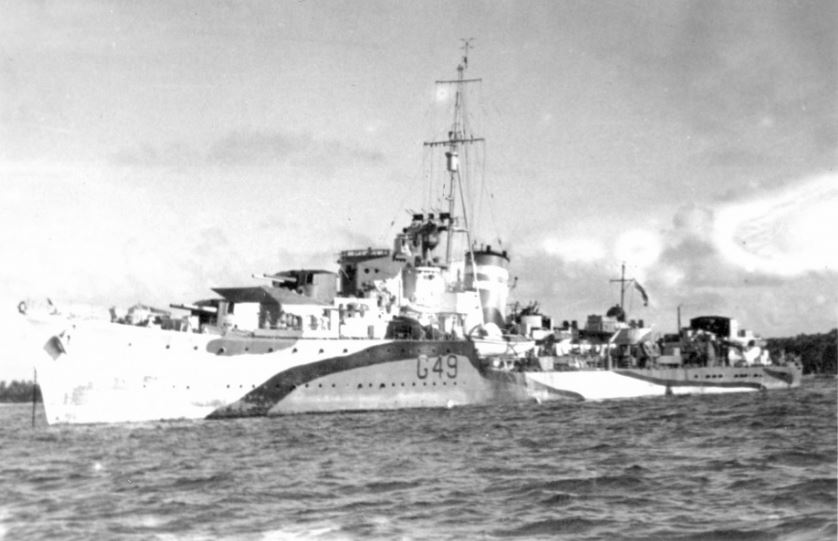Difference between revisions of "HMAS Norman"
From Our Contribution
(Created page with "{{Infobox ship | image = File:HMAS_Norman.jpg | caption = | image2 = File:HMAS_Norman_1.jpg | caption2 = | shipname = HMAS Norman (G49)...") |
(No difference)
|
Revision as of 03:01, 25 March 2023
Remarks
Following trials, Norman proceeded to Scapa Flow. In October 1941 she conveyed a delegation to Murmansk in Russia. A brief period of escort duties with the Home Fleet followed. In December she returned to the Thornycroft yards at Southampton for minor modifications.
In January 1942 Norman was allocated to the Eastern Fleet and proceeded to the Indian Ocean protecting the troop convoy WS 15. In February and March 1942, Norman was mainly engaged on Indian Ocean escort duties and screening heavy units of the Eastern Fleet. She became part of a large fleet to protect Ceylon, including HMAS Vampire. For three days and two nights the Eastern Fleet cruised south of Ceylon without sighting enemy units before returning to Addu Atoll. Shortly afterwards a Japanese force wa sighted some 360 miles off the Ceylon coast. This was the carrier task force under the command of Vice Admiral Nagumo, comprising six aircraft carriers, four battleships, three cruisers and twelve destroyers. Substantially the same force that had carried out the attacks on Pearl Harbor and Darwin, it had sailed from Kendari on 26 March.
On 5 April the Eastern Fleet sortied from Addu Atoll, with Norman operating as part of the screen. It remained at sea between the Maldives and Ceylon, avoiding the superior enemy forces by day and seeking opportunities to attack by air at night, until 8 April, when it returned to Addu Atoll. On 8 Apr 1942, the Japanese were in complete naval control of the Bay of Bengal and able to assert superiority in waters south of Ceylon, causing the withdrawl of the Eastern Fleet from Addu Atoll. Norman assumed escort duties, arriving in Bombay at the close of April 1942.
In May it was decided to reinforce the Mediterranean Fleet from forces available in the Indian Ocean for the passage of two Malta convoys, one from Gibraltar, the other from Egypt. The forces sent to cover the eastern convoy (westbound) of Operation VIGOROUS including the four Australian N Class destroyers Norman, Napier, Nestor and Nizam.
The eastern convoy was forced to return to Egypt as a result of the Italian fleets operations, and a shortage of fuel. One cruiser, three destroyers, including HMAS Nestor and two merchant ships were sunk and several ships including three cruisers were damaged. Counter attack in the air sank the Italian cruiser Trento and severely damaged other units of the enemy fleet.
Returning to the Indian Ocean, Norman (I) resumed escort and patrol duties. In September 1942, operating under the command of Rear Admiral WG Tennant (4th Cruiser Squadron), she took part in the second Madagascar campaign (10-29 September), which ended with the British occupation of the entire island.
In the period of October to December 1942, Norman (I) was engaged in routine Indian Ocean escort and fleet screening duties.
In January 1943 Norman (I) was engaged escorting convoys between Kilindini and Madagascar. The following month she was one of the escorts for the convoys returning 30,000 AIF troops from the Middle East to Australia. In March and April she was alongside for refitting at Simonstown.
From May to December 1943, Norman (I) was almost constantly occupied escorting Indian Ocean convoys. On 23 June 1943 Commander HJ Buchanan DSO RAN assumed command from Commander Burrell. At this stage of her service the ship had steamed 124,000 miles and had been underway for some 7500 hours.
In June she was engaged in escorting duties northwards through the Mozambique Channel. July was spent in dock at Durban and in August she escorted the United Kingdom to India convoy, WS 32, from the Congo River on the African west coast to Durban and thence northwards.
In October she arrived in Bombay remaining in Indian waters, patrolling, escorting and exercising until 14 December, when she departed Colombo to return to Kilindini. The last day of 1943 found Norman (I) escorting the battleship HMS Ramillies to Aden.
In January 1944 Norman (I) joined Force A, Eastern Fleet, at Aden, under the command of Vice Admiral AJ Power, flying his flag in HMS Renown. On 27 January Force A arrived at Colombo. The next two months were spent exercising with the fleet, interspersed with convoy escort duties. In March the fleet joined forces with an American task force comprising USS Saratoga and three destroyers, the combined force entering Trincomalee on 31 March.
In April 1944 Norman (I) arrived in Australian waters for the first time, arriving in Sydney on 24 April for a two month refit. In July she returned to the Eastern Fleet at Trincomalee to resume escort and patrol duties in the Indian Ocean, including screening the French battleship Richelieu from Colombo to Aden.
In mid-October a striking force of the Eastern Fleet was formed for an attack on the Nicobar Islands, to coincide with the American landings at Leyte in the Philippines. The force, commanded by Vice Admiral Sir Arthur Power, comprised Renown (Flag), the carriers Indomitable and Victorious, four cruisers and nine destroyers, including Norman (I). Phase one began with an air attack on 17 October and was followed by night bombardment carried out by the cruiser HMS London, Norman (I) and the Dutch destroyer Van Galen. On completion of their task the bombardment group detached for Trincomalee. The remainder of the month was spent by Norman (I) in the waters off Ceylon, exercising and escorting.
Norman (I) spent November and December 1944 on escort duty, including screening the carrier Victorious. On 2 November Lieutenant Commander J Plunkett-Cole RAN assumed command.
On 1 January 1945 Norman (I) sailed from Durban screening HMS Unicorn, bound for Colombo, bringing to a close her war time service in the west Indian Ocean areas.
On 18 January Norman (I) sailed from Trincomalee for operations on the Burmese Arakan Coast. Sister ships Napier and Nepal were already engaged in the area having taken part in the capture of Akyab, the main Japanese base. Norman (I) was in company with HM Ships Pathfinder and Raider, escorting the battleship HMS Queen Elizabeth and the escort carrier HMS Ameer.
On 21 January the above named group plus the carrier HMS Phoebe and the destroyers HMS Rapid and HMAS Napier, covered the landing of Indian troops on Ramree Island, Operation MATADOR. There was little opposition shore following the heavy shelling and the bombing of the Japanese defences. Attempted counter attack in the air was driven off without loss to the allied forces. On 23 January Norman (I) withdrew to Akyab.
On 26 January Norman (I) sailed from Akyab as one of the escorts to Ameer. The following day Task Force 65 (Rear Admiral AD Read) joined company. It comprised the cruisers HM Ships Newcastle, Nigeria and Kenya, and the destroyer HMS Paladin, plus the cruiser HMS Phoebe already operating in the Burma theatre. The objective of this force was the seizure of Cheduba Island by Royal Marines borne in the cruisers.
Naval bombardment began early on 26 January, Norman (I) adding her quota of 214 rounds of 4.7-inch ammunition to the shellfire. The succeeding landings, following strafing by aircraft from Ameer, met with little opposition. Admiral Sir Arthur Power, Commander-in-Chief, East Indies Fleet, witnessed the operations flying his flag in HMAS Nepal.
Norman (I) continued her operations in the Burma theatre until the close of the month. On 30 January she and the destroyer Raider successfully silenced Japanese field guns on Sagu Island which had repulsed at attempted landing the previous day.
Norman (I) spent most of February 1945 on exercises from Trincomalee and escorting the carrier Formidable. On 1 March she sailed for Fremantle, arriving on 10 March and reaching Sydney on 16 March.
On 1 April 1945 Norman (I) sailed from Sydney in company with Napier (Captain (D) 7th Flotilla) en route for the Philippines to commence operations as units of the British Pacific Fleet. In mid April Norman (I) joined Task Force 57 and between 14 and 20 April operation on the screen during the daily carrier air strikes against Okinawa as part of Operation ICEBERG. On 24 April Task Force 57, the main units being the 1st Battle Squadron, HM Ships King George V (Flag) and Howe; and the 1st Carrier Squadron, HM Ships Indomitable, Victorious, Illustrious and Indefatigable, returned to Leyte.
The British Task Force sailed from Leyte to resume the attacks against the Sakishima Gunto area on 1 May. In the initial stages of the second phase of Operation ICEBERG, the 7th Destroyer Flotilla of Napier, Norman (I), Nizam and Nepal, acted as escorts to the Fleet Train, replenishing the fleet at sea.
On 19 May Norman (I) joined Task Force 57 to become one of a carrier screening force of seventeen destroyers. She remained with the fleet until 22 May when she detached to escort the destroyer HMS Quilliam, which had been damaged in a collision with Formidable) to Leyte. Operation ICEBERG ended on 25 May.
The British Pacific Fleet operating as a part of the United States Navy 5th Fleet was at sea, except for eight days at Leyte, for 62 days. During these operations, in addition to the fleet bombardments, 4852 sorties were flown from the carriers, for the loss of 125 aircraft.
On 6 June 1945 Norman (I) returned to Sydney and remained in port until the end of the month. On 4 July she arrived in Manus with the 7th Destroyer Flotilla where she assumed the role of general duty and escort destroyer. In one period in July she visited 82 ships, carrying mail and stores and transferring 221 officers and ratings by jackstay.
Hostilities ceased on 15 August 1945. In September Norman (I) proceeded to Japan but arrived in Tokyo too late for the surrender ceremony.
Battle Honours
- Indian Ocean 1941-45
- Eaast Indies 1940 - 44
- Burma 1944 - 45
- Okinawa 1945
Crew
- William Henry Knox 16 Sep 1941 - 18 Nov 1942

